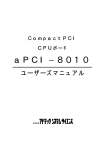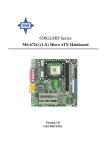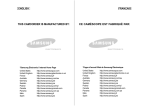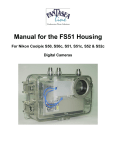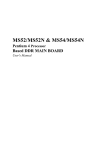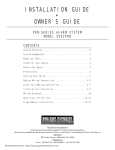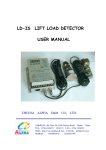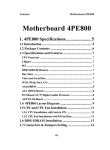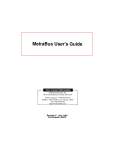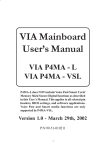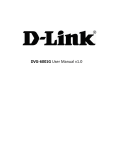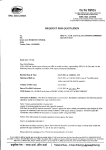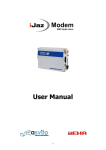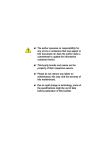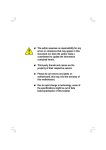Download TABLE OF CONTENTS
Transcript
TABLE OF CONTENTS WHAT'S IN THE MANUAL ..................................................................... 5 Quick Reference ................................................................................................ 5 About This Manual ............................................................................................ 5 1 INTRODUCTION ................................................................................. 6 1.1 TO DIFFERENT USERS .............................................................................. 6 FIRST-TIME DIY SYSTEM BUILDER ............................................................ 6 EXPERIENCED DIY USER ......................................................................... 6 SYSTEM INTEGRATOR ............................................................................... 6 1.2 ITEM CHECKLIST: ....................................................................................... 7 2 FEATURES .......................................................................................... 8 2.1 SPECIFICATIONS ........................................................................................ 8 3 HARDWARE INSTALLATION ........................................................... 11 3.1 STEP BY STEP INSTALLATION ................................................................ 11 Accessories of FS51 ............................................................................. 11 STEP 1 CPU Installation ......................................................................... 12 STEP 2 Set Jumpers .............................................................................. 14 STEP 3 Install DDR SDRAM System Memory ........................................ 14 STEP 4 Install Internal Peripherals in System Case ................................. 15 STEP 5 Mount the Mainboard on the Computer Chassis ........................ 16 STEP 6 Connect Front Panel Switches/LEDs/Speaker/USB .................. 17 STEP 7 Connect IDE and Floppy Disk Drives......................................... 18 STEP 8 Connect Other Internal Peripherals ............................................ 18 STEP 9 Connect the Power Supply ........................................................ 19 STEP 10 Install Add-on Cards in Expansion Slots .................................. 19 STEP 11 Connect External Peripherals to Back-Panel............................ 20 STEP 12 First Time System Boot Up ...................................................... 21 STEP 13 Install Drivers & Software Components .................................... 22 -1- 3.2 JUMPER SETTINGS .................................................................................. 23 JUMPERS & CONNECTORS GUIDE .................................................... 24 Jumpers Clear CMOS Setting (JP1) .................................................................... 27 Back-Panel Connectors COM1/2 Port Connectors ....................................................................... 28 VGA Port Connector............................................................................... 28 IEEE 1394 Port Connectors ................................................................... 28 10/100 base-T LAN Port Connector........................................................ 28 USB0/1 Port Connectors ........................................................................ 29 PS/2 Keyboard & PS/2 Mouse Connectors ............................................ 29 Bass/Center-Out Port Connector ............................................................ 29 Line-Out (Front-Out) Port Connector .......................................................29 Line-In (Rear-Out) Port Connector .......................................................... .30 SPDIF In Port ........................................................................................ .30 Front-Panel Connectors ATX Power On/Off Switch Connector (PWON) ........................................ 31 HDD LED Connector (HLED) .................................................................31 Green LED / Power LED Connector (GLED/PLED)................................ 32 Hardware Reset Connector (RST) .......................................................... 32 Extended USB Headers (JP3/JP10) .......................................................33 Front-Panel 1394 Header (JP5).............................................................. 33 Parallel Port Header (JP11) .................................................................... 34 Front-Panel Microphone and Line_out Header (JP4) .............................. 34 Internal Peripherals Connectors Enhanced IDE and Floppy Connector ..................................................... 35 Other Connectors ATX Power Supply Connector (CN5 and JP7) ........................................ 36 -2- CPU and System Fan Connector - FAN1/2/3) ......................................... 37 Audio CD_IN Connector (CN3) (Black) ................................................... 37 Wireless Keyboard and Mouse Connectors (JP2) .................................. 38 SPDIF Ext/In/Out Headers (JP9) ............................................................. 38 3.3 SYSTEM MEMORY CONFIGURATION ...................................................... 39 INSTALL MEMORY ................................................................................ 39 UPGRADE MEMORY............................................................................. 39 4 SOFTWARE UTILITY .......................................................................4 0 4.1 Mainboard CD Overview .......................................................................... 40 4.2 Install SIS VGA Driver ............................................................................... 41 4.3 Install SIS AGP Driver ............................................................................... 42 4.4 Install Audio Driver ................................................................................... 43 4.5 Install LAN Driver ...................................................................................... 44 Install WIN98 LAN driver ......................................................................... 44 4.6 Install USB 2.0 Driver ............................................................................... 47 4.7 View the User's Manual ............................................................................ 48 5 BIOS SETUP .....................................................................................4 9 5.1 ENTER BIOS .............................................................................................. 49 5.2 THE MAIN MENU ....................................................................................... 50 STANDARD CMOS FEATURES ................................................................ 52 ADVANCED BIOS FEATURES .................................................................. 55 ADVANCED CHIPSET FEATURES ........................................................... 59 INTEGRATED PERIPHERALS ................................................................... 61 POWER MANAGEMENT SETUP .............................................................. 65 PNP/PCI CONFIGURATIONS ..................................................................... 68 PC HEALTH STATUS ................................................................................. 70 FREQUENCY/VOLTAGE CONTROL .......................................................... 72 -3- LOAD FAIL-SAFE DEFAULTS ................................................................... 73 LOAD OPTIMIZED DEFAULTS .................................................................. 74 SET PASSWORD ...................................................................................... 75 SAVE & EXIT SETUP................................................................................. 76 EXIT WITHOUT SAVING ............................................................................. 77 -4- WHAT'S IN THE MANUAL Quick Reference Hardware Installation >> Step-by-Step ................................................ Page 11 Jumper Settings >> A Closer Look ...................................................... Page 23 Drivers/Software Utilities >> How to Install ......................................... Page 40 BIOS Setup >> How to Configure ........................................................ Page 49 About This Manual For First-Time DIY System Builder ......................................................... Page 6 For Experienced DIY User ...................................................................... Page 6 For System Integrator ............................................................................. Page 6 -5- 1 INTRODUCTION 1.1 To Different Users First-Time DIY System Builder Welcome to the DIY world! Building your own computer system is not as difficult as you may think. To make your first computer DIY experience successful, right from the start, we have designed the 3.1 Hardware Installation section in a step-by-step fashion for all the first-time DIY system builders. Prior to installation, we also suggest you to read the whole manual carefully to gain a complete understanding of your new Shuttle FS51 mainboard. Experienced DIY User Congratulate on your purchase of the Shuttle FS51 mainboard. You will find that installing your new Shuttle FS51 mainboard is just easy. Bundled with an array of onboard functions, the highly-integrated FS51 mainboard provides you with a total solution to build the most stable and reliable system. Refer to sections 3.2 Jumper Settings and Chapter 4 Drivers/Software Utilities to find out how to get the best out of your new mainboard. Chapter 5 BIOS Setup also contains the relevant information on how to tune up your system to achieve higher performance. System Integrator You have wisely chosen Shuttle FS51 to construct your system. Shuttle FS51 incorporates all the state-of-the-art technology of the SiS 651 chipset from SiS. It integrates the most advanced functions you can find to date in a compact Flex ATX board. -6- 1.2 Item Checklist: Check all items with you FS51 mainboard to make sure nothing is missing. The complete package should include: 1 JP11 C D-CN I N3 1 1 FA N1 U 004 0A I C 95 02SW200 0323 4A F FD D 1 JP11 FA N3 P CI 1 A L03C S1 6 5 21 0 6E 2 41 ! One piece of Shuttle FS51 Mainboard 13 94 A M I C A2 90021 012 2T TL- 70 B3 X5A A GP 1 SPD IF JP9 1 JP1 JP3 US B 1 1 FA N2 651 C S IS 0 ' 1 PL D 4 8 9 2 0 1 4 5 EA C S IS 0 ' 0 EL 0 1D 3 82E6A9 1 S9 6 2 i S S iS US B JP10 JP7 1 D IM M D 1 IM M 2 I DE 2 + --+ ! One piece of Floppy Ribbon Cable ! One piece of twin ports USB Cable (optional) ! FS51 User's Manual ! One piece of Bundled CD-ROM with containing: " FS51 user's manual saved in PDF format " SiS Chipset driver " Realtek Audio driver " SiS VGA driver " LAN driver " Award Flashing Utility -7- RS T- HLE + D JP8PW GLE ON D/ PLE ! One piece of ATA133/100 Ribbon Cable 1 I DE 1 CN 5 AT XP W .-)674-5 FS51 mainboard is carefully designed for the demanding PC user who wants high performance and maximum intelligent features in a compact package. 2.1 Specifications ! CPU Support Intel Pentium 4 / Celeron, 478-pin processors with 400/533 MHz FSB. ! Chipset Features SiS 651 N.B. and SiS 962L S.B.. Onboard Lan Realtek 8100B, support 10Mb/s and 100Mb/s operation. Onboard 1394 VIA VT6306, support 400Mb/s, 200Mb/s, 100Mb/s data transfer rate. ! Jumperless CPU Configuration Soft-configuration FSB (The FSB speed is software configurable from 100MHz to 166MHz in the Frequency/Voltage Control of BIOS setup program.) ! On Board 6 Channel AC97 Audio Compliant with AC'97 2.2 specifications. 6 channel slot selectable DAC Output for multi-channel applications. ! Versatile Memory Support Two 184-pin DIMM slots to support up to 2GB of PC1600, PC2100 or PC2700 compliant DDR SDRAM module. ! AGP Expansion Slot Provides one 32-bit AGP slot which support 2X / 4X AGP device. ! PCI Expansion Slots Provides one 32-bit PCI slot. ! 6 USB 2.0 Interface Onboard " 2 x USB 2.0 connectors on back-panel and one sets of dual USB ports headers on mid-board. -8- ! I/O Interface Provides a variety of I/O interfaces: " 1 x Floppy interface for 3.5-inch FDD with 720KB, 1.44MB, or 2.88MB format or for 5.25-inch FDD with 360K or 1.2MB format. " 2 x DB9 Serial connectors 16550 UART compatible. " 1 x DB15 VGA connector. " 1 x SPDIF-In port. " 2 x 1394 connectors. " 1 x RJ45 LAN connector. " 1 x PS/2 mouse connector. " 1 x PS/2 Keyboard connector. " 1 x Line-Out (Front-Out) port. " 1 x Line-In port, shared with rear speaker output when multi-channel audio is enabled. " 1 x Bass/Center-Out port. ! PCI Bus Master IDE Controller Onboard Two Ultra DMA 133/100 Bus Master Dual-channel IDE ports provide support to a maximum of four IDE devices (one Master and one Slave per channel). The IDE Bus implements data transfer speeds of up to 133/100 MB/sec and also supports Enhanced PIO Modes. 80-pin Cable Backward Compatible Legacy ATAPI Devices, ATAPI IDE CDROM, CD-R, CD-RW, and LS-120 Supports. ! ATX Power Supply Connector ATX power supply unit can connected to the onboard 20-pin Pentium 4 standard ATX power connectors, supporting Suspend and Soft-On/Off by dual-function power button. The Pentium 4 ATX power include other 4-pin +12V ATX power connector. ! Advanced Configuration and Power Interface Features four power saving modes: S1 (Snoop), S3 (Suspend to RAM), S4 (Suspend to DISK), and S5 (Soft-Off). ACPI provides more efficient Energy Saving Features controlled by your operating system that supports OS Direct Power Management (OSPM) functionality. -9- ! System BIOS Provides licensed Award BIOS V6.0 PG on 2Mb Flash core and supports Green PC, Desktop Management Interface (DMI). ! Form Factor System board conforms to Shuttle from factor ATX specification. Board dimension: 254mm x 185mm. ! Advanced Features " Low EMI - Built in spread spectrum and automatic clock shut-off of unused PCI/SDRAMS slots to reduce EMI. " Dual Function Power Button - The system can be in one of two states, one is Suspend mode and the other is Soft-Off mode. Pushing the power button for less than 4 seconds places the system into Suspend mode. When the power button is pressed for longer than 4 seconds, the system enters Soft-Off mode. " Modem Ring Power-On - The system can be powered on automatically by the activation of modem ringing. " CPU Host/SDRAM Clock Setting - This item allows users to adjust CPU Host Clock, and SDRAM, and Clock in BIOS. " CPU Multiplier Setting - This item allows users to adjust CPU Multiplier in BIOS. ! Intelligent Features " Voltage Monitoring - Monitors various voltages of key elements, such as the CPU, and other critical system voltage levels to ensure stable current passing through mainboard components. " Fan Status Monitoring - To prevent CPU from overheating, the CPU fan is monitored for RPM and failure. (CPU Cooling FAN with RPM sensor is required.) " Temperature Monitoring - This item allows users to make sure whether the CPU or system runs in a suitable temperature. " CPU Fan AutoGuardian - This SMART Bios enabled 3 phase Variable Fan Speed and CPU temperature Control feature. - 10 - 3 HARDWARE INSTALLATION Before removing or installing any of these devices including CPU, DIMMs, Add-On Cards, Cables, please make sure to unplug the onboard power connector. This section outlines how to install and configure your mainboard. Refer to the following mainboard layout to help you to identify various jumpers, connectors, slots, and ports. Then follow these steps designed to guide you through a quick and correct installation of your system. 3.1 Step-by-Step Installation Accessories Of FS51 1 FAN1 UW230040A 0203 952004AF 1394 A M IC A 29 00 21T L- 70 0 122T B 3X 5A Programmable 2Mb Flash EEPROM PCI 1 1 IC S One Floppy Connector 1 JP11 FDD 21 6 E A L C 6 5 0 CD-IN CN3 1 JP3 USB JP1 1 1 FAN2 SiS 651 SIS' 01 PLD4892 0145EA C USB JP10 962L C SIS' 00 ELD2691 0138EA S iS SiS 962L Chipset JP7 1 DIMM1 DIMM2 Front-Panel Connectors - JP8 IDE 2 HLED - + + - - + RST JP8 PWON GLED/PLED 1 CN5 IDE 1 Two IDE Connectors - 11 - ATX Power Connector SiS 651 Chipset ATXPWR FAN2 ATX 12V Power Connector - JP7 Two 184-pin DDR-SDRAM DIMM Slots FAN1 1 JP9 Clear CMOS - JP1 Extended USB 2.0/1.1 Header - JP10 1 JP11 FAN3 SPDIF SOCKET 478 One AGP Slots Extended USB 2.0/1.1 Header - JP3 COM2 Connectors SPDIF In Port Parallel Connector COM1 & VGA Connectors AGP Onboard CD-IN Connector - CN3 Wireless KB and MS Header - JP2 1394 Header - JP5 Front Audio Header - JP4 One PCI Slot RTL8100B LAN Controller 1394 Controller SPDIF Ext/In/Out Header s - JP9 2 4 1 0 3 S 1 1394 Connectors LAN & USB 2.0/1.1 Connectors PS/2 Keyboard/Mouse Connectors 5.1 Channel Audio Connectors FAN3 Audio Controller Step 1 CPU Installation: This mainboard supports Intel® Pentium® 4 /Celeron, Socket 478 series CPU. Please follow the step as below to finish CPU installation. Be careful of CPU orientation when you plug it into CPU socket. 1. Pull up the CPU socket lever and up to 90-degree angle. CPU socket lever up to 90 degree 2. Locate Pin 1 in the socket and look for a black dot or cut edge on the CPU upper interface. Match Pin 1 and cut edge, then insert the CPU into the socket. CPU pin 1 and cut edge - 12 - 3. Press down the CPU socket lever and finish CPU installation. Note: If you do not match the CPU socket Pin 1 and CPU cut edge well, it may damage the CPU. - 13 - Step 2. Set Jumpers This mainboard is jumperless! The default jumper settings have been set for the common usage standard of this mainboard. Therefore, you do not need to reset the jumpers unless you require special adjustments as any of the following cases: Clear CMOS For first-time DIY system builders, we recommend that you do not change the default jumper settings if you are not totally familiar with the mainboard configuration procedures. The factory-set default settings are tuned for optimum system performance. For the advanced users who wish to customize their system, section 3.2 Jumper Settings will provide detailed information on how to configure your mainboard manually. Step 3 Install DDR SDRAM System Memory To install memory, insert DDR SDRAM memory module(s) in DIMM slot(s). Note that DDR SDRAM modules are directional and will not go in the DIMM slots unless properly oriented. After the module is fully inserted into the DIMM slots, lift the clips of both sides of the DIMM slot to lock the module in place. DDR SDRAM - 14 - Step 4 Install Internal Peripherals in System Case Before you install and connect the mainboard into your system case, we recommend that you first assemble all the internal peripheral devices into the computer housing, including but not limited to the hard disk drive (IDE/ HDD), floppy disk drive (FDD), CD-ROM drive, and ATX power supply unit. This will greatly facilitate in making the connections to the mainboard described below. To install IDE & FDD drives, follow this procedure: 1. Set the required jumpers on each device according to the instructions provided by the manufacturer. (IDE devices, HDD, and CD-ROM, have to set jumpers to Master or Slave mode depending on whether you install more than one device of each kind.) 2. Connect IDE cable and FDD cable on the back-panel of the internal peripheral devices to the corresponding headers on board. Note that the cable should be oriented with its colored stripe (usually red or magenta) connected to pin#1 both on the mainboard IDE or FDD connector and on the device as well. 3. Connect an available power cable from your system power supply unit to the back-panel of each peripheral device. Note that the power cable is directional and cannot fit in if not properly positioned. - 15 - 5JAF # Mount the Mainboard on the Computer Chassis 1. You may find that there are a lot of different mounting hole positions both on your computer chassis and on the mainboard. To choose correct mounting holes, the key point is to keep the back-panel of the mainboard in a close fit with your system case, as shown below. 2. After deciding on the proper mounting holes, position the studs between the frame of the chassis and the mainboard. The studs are used to fix the mainboard and to keep a certain distance between the system's chassis and the mainboard, in order to avoid any electrical shorts between the board and the metal frame of the chassis. (If your computer case is already equipped with mounting studs, you will need to tighten screws to attach the mainboard.) Note: In most computer housings, you will be able to find 4 or more attachment points to install mounting studs and then fix the mainboard. If there aren't enough matching holes, then make sure to install at least 4 mounting studs to ensure proper attachment of the mainboard. - 16 - Step 6 Connect Front Panel Switches/LEDs/Speaker/USB You can find there are several different cables already existing in the system case and originating from the computer's front-panel devices (HDD LED, Power LED, Reset Switch, or USB devices etc.) These cables serve to connect the front-panel switches, LEDs, and USB connectors to the mainboard's front-panel connectors group (JP3, JP8, JP10), as shown below. 1 USB JP3 1 USB JP10 HLED - + JP8 + - - + RST PWON GLED/PLED 1. 2. 3. 4. 5. 1 ATX Soft Power On/Off (PWON) HDD-LED (HLED) Green-LED and Power-LED (GLED/PLED) Hardware Reset Switch Button (RST) Extended USB Header # PWON PLED HLED ! +5V RST - + + - - + GLED " USB port 3 USBD0USBD0+ GND KEY 1 - 17 - 1 3 5 7 9 2 +5V 4 USBD16 USBD1+ 8 GND 10 N/A USB port 2 JP3 / JP10 5JAF % Connect IDE and Floppy Disk Drives 1. IDE cable connector 1 IDE2 1 IDE1 FDD 1 2. Floppy cable connector 5JAF & Connect Other Internal Peripherals 1. CD-IN (CN3), Microphone and Line-Out (JP4) connectors 1 CN3 CD-IN 1 JP4 1 2. 1394 header (JP5) - 18 - 1394 JP5 3. Wireless keyboard and mouse headers (JP2) JP2 1 5JAF ' JP7 Connect the Power Supply 1. System power connector 1 1 CN5 5JAF Install Add-on Cards in Expansion Slots 1. Accelerated Graphics Port (AGP) Card 1. PCI Card - 19 - ATXPWR Step 11 Connect External Peripherals to Back-Panel You are now ready to put the computer case back together and get on to the external peripherals connections to your system's back-panel. 1. 2. 3. 4. 5. 6. 7. 8. 9. 10. 11. 12. COM1 Port COM2 Port VGA Port SPDIF In Port 1394 Ports LAN Port USB0/1 Ports PS/2 Mouse PS/2 Keyboard Audio Line-Out (Front-Out) Port Audio Line-In (Rear-Out) Port Audio Bass/Center-Out Port ! " # - 20 - $ & % ' Step 12 First Time System Boot Up To assure the completeness and correctness of your system installation, you may check the above installation steps once again before you boot up your system for the first time. 1. Insert a bootable system floppy disk (DOS 6.2x, Windows 95/98/NT, or others) which contains FDISK and FORMAT utilities into the FDD. 2. Turn on the system power. 3. First, you must use the FDISK utility to create a primary partition of the hard disk. You can also add an extended partition if your primary partition does not use all of the available hard disk space. If you choose to add an extended partition, you will have to create one or more logical partitions to occupy all the space available to the extended partition. The FDISK utility will assign a drive letter (i.e., C:, D:, E:,...) to each partition which will be shown in the FDISK program. After FDISK procedure, reboot your system by using the same system floppy disk. Note: DOS 6.2x and Windows 95A can only support up to 2.1GB of HDD partition. If you use the FDISK utility with one of the operating systems mentioned above, you can only install your HDD into partitions no larger than 2.1GB each. 4. Now, use the FORMAT utility to format all the partitions youve created. When formatting the primary partition (C:), make sure to use the FORMAT C: /S command. Note: FORMAT C: /S can transfer all the necessary system files into the primary partition of your hard disk. Then, your HDD will become a bootable drive. 5. Install all the necessary drivers for CD-ROM, Mouse, etc. 6. Setup the complete operating system according to your OS installation guide. - 21 - 5JAF ! Install Drivers & Software Components Please note that all the system utilities and drivers are designed for Win 9x/ 2000/ME/XP/NT operating systems only. Make sure your operating system is already installed before running the drivers installation CD-ROM programs. 1. Insert the FS51 bundled CD-ROM into your CD-ROM drive. The autorun program will display the drivers main installation window on screen. 2. Choose "Install SIS VGA Device Driver" and complete it. 3. Choose "Install SIS AGP Driver" and complete it. 4. Choose "Install Audio Device Driver" and complete it. 5. Choose "Install LAN Driver" and complete it. 6. Exit from the autorun drivers installation program. ! Please refer to section Chapter 4 Software Utility to install driver. - 22 - 3.2 Jumper Settings Several hardware settings are made through the use of mini jumpers to connect jumper pins on the mainboard. Pin #1 could be located at any corner of each jumper, you just find the location with a white right angle which stands for pin 1#. There are several types of pin 1# shown as below: 3-pin and multi (>3) pin jumpers shown as following: Pin #1 to the left: Pin #1 on the top: Pin #1 to the right: Pin #1 on the bottom: Jumpers with two pins are shown as for Close [On] or for Open [Off]. To Short jumper pins, simply place a plastic mini jumpers over the desired pair of pins. Caution! 1. Do not remove the mainboard from its antistatic protective packaging until you are ready to install it. 2. Carefully hold the mainboard by its edges and avoid touching its components. When putting the mainboard down, place it on top of its original packaging film, on an even surface, and components side up. 3. Wear an antistatic wrist strap or take other suitable measures to prevent electrostatic discharge (ESD) whenever handling this equipment. - 23 - Jumpers & Connectors Guide Use the mainboard layout on page 11 to locate CPU socket, memory banks, expansion slots, jumpers and connectors on the mainboard during the installation. The following list will help you to identify jumpers, slots, and connectors along with their assigned functions: B7 B11 B4~B6 B3 B8~B10 B1~B2 E4 C7 E5 E6 D1 C8 E2 E7 C6 C5 A1 E3 E1 C1~C4 D2~D3 E1 CPU/Memory/Expansion Slots Socket478 : CPU Socket for Pentium 4 processors DIMM1/2 : Two184-pin DIMM Slots for 64, 128, 256, 512 MB, and 1GB of 2.5V DDR SDRAM (The total installed memory does not exceed 2GB) AGP : One AGP 2X / 4X Slot - 24 - PCI Jumpers ) JP1 : Two 32-bit PCI Expansion Slot : Clear CMOS setting Back Panel Connectors * * COM1/2 : Serial port 1/2 (DB9 male) *! *" *# *$ *% *& *' * * + + +! +" +# +$ +% +& , , ,! VGA 1394 LAN USB MS KB BASS/CENTER LINE-OUT LINE-IN SPDIF : VGA port (DB15 female) : 2 x 1394 (0/1) Ports : 10/100 base-T LAN Port : 2 USB 2.0/1.1 (0/1) (Universal Serial Bus) ports : PS/2 mouse port : PS/2 keyboard port : Audio Bass/Center-Out Port : Audio Line-Out (Front-Out) Port : Line-In (Rear-Out) Port : SPDIF In Port Front Panel Connectors PWON : ATX power on/off momentary type switch HLED : IDE drive active LED GLED/PLED : Green LED (ON when system stays in power saving mode) / System power LED RST : Hardware reset switch JP3/JP10 : Extended USB Header (USB2.0/1.1) JP5 : Front Panel 1394 header JP11 : Parallel Connector JP4 : Front-Panel Microphone and Line-Out Connector Internal Peripherals Connectors FDD : Floppy disk drive interface IDE1 : IDE primary interface (Dual-channel) IDE2 : IDE secondary interface (Dual-channel) Other Connectors - CN5/JP7 FAN1 FAN2 -! : ATX power connector : System fan connector : Chipset fan connector - 25 - -" -# -$ -% FAN3 CN3 JP2 JP9 : CPU fan connector : Audio CD_IN connector : Wireless Keyboard and Mouse connector : SPDIF Ext/In/Out connectors - 26 - " Jumpers ) Clear CMOS Setting (JP1) JP1 is used to clear CMOS data. Clearing CMOS will result in the permanently erasing previous system configuration settings and the restoring original (factory-set) system settings. 1 Pin 1-2 (Default) JP1 1 1 Pin 2-3 (Clear CMOS) Step 1. Turn off the system power (PC-> Off). Step 2. Remove ATX Power cable from ATX Power connector. Step 3. Remove jumper cap from JP1 pins 1-2. Step 4. Place the jumper cap on JP1 pin 2-3 for a few seconds. Step 5. Return the jumper cap to pin 1-2. Step 6. Plug ATX Power cable into ATX Power connector. Step 7. Turn on the system power (PC-> On). - 27 - " Back-Panel Connectors * * *! COM1/2 Port Connectors This mainboard can accommodate one serial device on COM1/2. Attach a serial device cable to the DB9 serial port COM1/2 at the backpanel of your computer. COM1 Port COM2 Port VGA Connector One 15-pin VGA connector is located at the rear panel of the mainboard. VGA Port *" IEEE 1394 Port Connectors This mainboard offers two 1394 ports on back-panel. Plug each device jack into an available 1394 connector. *# IEEE1394 Port 0 IEEE1394 Port 1 10/100 base-T LAN Port Connector This mainboard can accommodate one device on LAN. Attach a RJ45 cable to the LAN port at the back-panel of your computer. - 28 - LAN Port *$ USB Port 0/1 Connectors USB Port 1 Two female connectors USB0/USB1 share the same USB (Universal Serial Bus) bracket at the rear panel of your mainboard. Plug each USB device jack into an available USB0/USB1 connector. *% PS/2 Keyboard & PS/2 Mouse Connectors Two 6-pin female PS/2 keyboard & Mouse connectors are located at the rear panel of the mainboard. Depending on the computer housing you use (desktop or tower), the PS/2 Mouse connector is situated at the top of the PS/2 Keyboard connector when the mainboard is laid into a desktop, as opposed to a tower where the PS/2 Mouse connector is located at the right of the PS/2 Keyboard's. Plug the PS/2 keyboard and mouse jacks into their corresponding connectors. *& Bass/Center-Out Port Connector Bass/Center-Out is a stereo output port through which the combined signal of all internal and external audio sources on the board is output. It can be connected to 1/8-inch TRS stereo headphones or to bass/center amplified speakers. *' USB Port 0 PS/2 Mouse PS/2 keyboard Bass/Center-Out Port Line-Out (Front-Out) Port Connector Line-Out is a stereo output port through which the combined signal of all internal and external audio sources on the board is output. It can be connected to 1/8-inch TRS stereo headphones or to amplified speakers. - 29 - Line-Out Port (Front-Out) * Line-In (Rear-Out) Port Connector Line-In is a stereo line-level input port that accepts a 1/8-inch TRS stereo plug. It can be used as a source for digital sound recording, a source to be mixed with the output, or both. * Line-In Port (Rear-Out) SPDIF In Port SPDIF IN connector can accept digital audio data from Optic fiber. SPDIF In Port - 30 - Front-Panel Connectors C1 ATX Power On/Off Switch Connector (PWON) The Power On/Off Switch is a momentary type switch used for turning on or off the system ATX power supply. Attach the connector cable from the Power Switch to the 2-pin (PWON) header on the mainboard. HLED - + JP8 + - - + RST PWON GLED/PLED 1 Note : Please notice all the LED connectors are directional. If your chassis's LED does not light up during running, please simply change to the opposite direction. C2 HDD LED Connector (HLED) Attach the connector cable from the IDE device LED to the 2-pin (HLED) header. The HDD LED lights up whenever an IDE device is active. RST 1 HLED JP8 - 31 - - + PWON GLED/PLED + - - + ! C3 Green LED / Power LED Connector (GLED/PLED) 2 4 GLED - + + - - + 1 HLED - + PLED + - RST JP8 Hardware Reset Connector (RST) Attach the 2-pin hardware reset switch cable to the (RST) header. Pressing the reset switch causes the system to restart. RST 1 HLED JP8 - 32 - - + PWON GLED/PLED + - - + C4 PWON GLED/PLED 2 4 This header is dual color LED function. Dual color LED function is defined by either Power LED or Green LED, the header can be in these states. The Green LED indicates that the system is currently in one of the power saving mode (Doze/Standby/Suspend). When the system resumes to normal operation mode, the Green LED will go off, power LED on. This Power LED will go off during power saving mode. Attach a 2-pin Green LED/Power LED cable to (GLED/PLED) header. C5 Extended USB Header (JP3/JP10) The headers are used to connect the cable attached to USB connectors which are mounted on front panel or back panel. But the USB cable is optional at the time of purchase. 1 2 4 6 USB port 2 8 10 USB JP3 1 3 USB port 3 5 7 9 1 USB JP10 Pins Assignment: 1=+5V 3=USBD07=GND 9=KEY 2=+5V 8=GND C6 5=USBD0+ 4=USBD110=N/A 6=USBD1+ Front-Panel 1394 Header - JP5 The header is used to connect the cable attached to 1394 connector which are mounted on front panel or back panel. But the 1394 cable is optional at the time of purchase. 2 4 6 8 10 1 3 5 7 9 Pins Assignment: 1=TPA+ 2=TPA3=GND 4=GND 5=TPB+ 6=TPB7=+12V 8=+12V 9=KEY 10=GND 1 - 33 - JP5 +% Parallel Port Header (JP11) One DB25 male parallel port header is located at the rear panel of the maiboard. The header is used to connect the cable attached to parallel connector. But the parallel cable and connector os optional at the time of purchase. 1 +& Front-Panel Microphone and Line_out Header (JP4) This header allows users to install auxiliary front-oriented microphone and lineout ports for easier access. Either the Mic and Line_out connector on backpanel or JP4 header are available at the same time. If you would like to use this JP4 header on front-panel, please remove all jumpers from JP4 and install your special Extra Mic / Line_out cable instead. JP4 2 4 6 8 10 1 1 3 5 7 9 Pins Assignment: 1=AUD_MIC 3=AUD_MIC_BIOS 5=AUD_FRONT_R 7=HP_ON 9=AUD_FRONT_L 2=AUD_GND 4=AUD_VCC 6=AUD_RET_R 8=KEY 10=AUD_RET_L - 34 - Front Audio ! Internal Peripherals Connectors D1 D2 D3 Enhanced IDE and Floppy Connectors The mainboard features two 40-pin dual-channel IDE device connectors (IDE1/IDE2) providing support for up to four IDE devices, such as CD-ROM and Hard Disk Drives (H.D.D.). This mainboard also includes one 34-pin floppy disk controller (FDC) to accommodate the Floppy Disk Drive (FDD). Moreover, this mainboard comes with one 80-pin ATA 133/100 ribbon cable to connect to IDE H.D.D. and one 34-pin ribbon cable for F.D.D. connection. 1 1 IDE 2 1 IDE 1 FDD Important:Ribbon cables are directional, therefore, make sure to always connect with the red cable stripe on the same side as pin #1 of the IDE1/IDE2 or FDC connector on the mainboard. - 35 - !" Other Connectors E1 ATX Power Supply Connectors (CN5 and JP7) This motherboard uses 20-pin (CN5) Pentium 4 standard ATX power header, and JP7 with 1X4-pin +12V PC ATX power supply headers. Please make sure you plug in the right direction. JP7 1 P3/P4 ATX Power supply headers CN5 JP7 1 CN5 Note ATXPWR This motherboard can't support AC power resumes from power failure, you must press power button to power-on. Note 1: The ATX power connector is directional and will not go in unless the guides match perfectly making sure that pin#1 is properly positioned. Note 2: Make sure the latch of the ATX power connector clicks into place to ensure a solid attachment. Note 3: Your ATX power supply must be supplied to ACPI +5V standby power and at least 720mA compatible. Note 4: Make sure your power supply have enough power for higher speed processor installed. - 36 - -! -" CPU and System Fan Connectors - FAN1/2/3 The mainboard provides three onboard 12V cooling fan power connectors to support System (FAN1), Chipset (FAN2), or CPU (FAN3) cooling fans. 1 +12V FAN 1 GND SENSE FAN3 1 1 FAN1/2/3 with rotate sense. FAN 2 Note: 1 Both cable wiring and type of plug may vary , which depends on the fan maker. Keep in mind that the red wire should always be connected to the +12V header and the black wire to the ground (GND) header. -# Audio CD_IN Connector (CN3) (Black) Port CN3 is used to attach an audio connector cable from the CD-ROM drive. 1 CD_IN Left 2 3 4 GND CD_IN Right 1 CN3 CD-IN - 37 - -$ Wireless Keyboard and Mouse Connector (JP2) Port JP2 can be used to connect wireless keyboard and mouse device. 2 4 6 8 JP2 1 1 3 5 7 Pin Assignments: 1=+5V 2=KEY 3=MS-DT 4=KB-DT 5=MS-CK 6=KB-CK 7=GND 8=GND -% SPDIF Ext/In/Out Headers (JP9) Port JP9 can be used to connect special device. 2 4 6 8 10 2=VCC 4=SPDIF-OUT 6=GND 8=N/A 10=GND - 38 - JP9 Pin Assignments: JP9 1=+12V 3=N/A 5=SPDIF-IN 7=N/A 9=KEY 1 SPDIF 1 3 5 7 9 3.3 System Memory Configuration The FS51 mainboard has two 184-pin DIMM slots that allow you to install from 64MB up to 2GB of system memory. Each 184-pin DIMM (Dual In-line Memory Module) Slot can accommodate 64MB, 128MB, 256MB, 512MB, and 1GB of PC1600/PC2100/PC2700 compliant 2.5V single (1 Bank) or double (2 Bank) side 64-bit wide data path DDR SDRAM modules. Install Memory: Install memory in any or all of the slots and in any combination shown as follows. DIMM Socket Memory Modules Module Quantity DIMM 1 16MB, 32MB, 64MB, 128MB, 256MB, 512M ,and 1GB 184-pin 2.5V DDR SDRAM DIMM x1 DIMM 2 16MB, 32MB, 64MB, 128MB, 256MB, 512M ,and 1GB 184-pin 2.5V DDR SDRAM DIMM x1 Note: Maximum installed memory is 2GB. Note: You do not need to set any jumper to configure memory since the BIOS utility can detect the system memory automatically. You can check the total system memory value in the BIOS Standard CMOS Setup menu. Upgrade Memory: You can easily upgrade the system memory by inserting additional DDR SDRAM modules in available DIMM slots. The total system memory is calculated by simply adding up the memory in all DIMM slots. After upgrade, the new system memory value will automatically be computed and displayed in the field " Standard CMOS Setup" of BIOS setup program. - 39 - 4 SOFTWARE UTILITY 4.1 Mainboard CD Overview Note: The CD contents attached in FS51 mainboard are subject to change without notice. To start your mainboard CD disc, just insert it into your CD-ROM drive and the CD AutoRun screen should appear. If the AutoRun screen does not appear, double click or run D:\Autorun.exe (assuming that your CD-ROM drive is drive D:) Navigation Bar Description: ! ! ! ! ! ! ! ! Install VGA Device Driver - Installing SIS VGA driver. Install SIS Chipset Driver - Installing SIS chipset driver. Install Audio Device Driver - Installing Audio driver. Install LAN Driver - Installing LAN driver. Manual - FS51 Series mainboard user's manual in PDF format. Link to Shuttle Homepage - Link to shuttle website homepage. Browse this CD - Allows you to see contents of this CD. Quit - Close this CD. " The NT Audio/VGA/LAN Device Driver and Win 9x LAN Device Driver must be installed manually. - 40 - 4.2 Install SIS VGA Driver Insert the attached CD into your CD-ROM drive and the CD AutoRun screen should appear. If the AutoRun screen does not appear, double click on Autorun icon in My Computer to bring up Shuttle Mainboard Software Setup screen. Select using your pointing device (e.g. mouse) on the Install VGA Device Driver bar to install SIS VGA driver. Once you made your selection, a Setup window run the installation automatically. When the copying files is done, make sure you reboot the system to take the installation effect. - 41 - 4.3 Install SIS AGP Driver Insert the attached CD into your CD-ROM drive and the CD AutoRun screen should appear. If the AutoRun screen does not appear, double click on Autorun icon in My Computer to bring up Shuttle Mainboard Software Setup screen. Select using your pointing device (e.g. mouse) on the Install SIS AGP Driver bar to install SIS chipset driver. Once you made your selection, a Setup window run the installation automatically. When the copying files is done, make sure you reboot the system to take the installation effect. - 42 - 4.4 Install Audio Driver Insert the attached CD into your CD-ROM drive and the CD AutoRun screen should appear. If the AutoRun screen does not appear, double click on Autorun icon in My Computer to bring up Shuttle Mainboard Software Setup screen. Select using your pointing device (e.g. mouse) on the Install Audio Device Driver bar to install Hardware Audio driver. Once you made your selection, a Setup window run the installation automatically. When the copying files is done, make sure you reboot the system to take the installation effect. - 43 - 4.5 Install LAN Driver Insert the attached CD into your CD-ROM drive and the CD AutoRun screen should appear. If the AutoRun screen does not appear, double click on Autorun icon in My Computer to bring up Shuttle Mainboard Software Setup screen. Select using your pointing device (e.g. mouse) on the “Install LAN Driver” bar to install LAN driver. Once you made your selection, a Setup window run the installation automatically. When the copying files is done, make sure you reboot the system to take the installation effect. Install WIN98 LAN driver The LAN Device Driver can't install automatically, you need double click on My Computer -> Control Panel -> System icon to bring up System Properties screen. Select tab "Device Manager". You will find a yellow "?" mark at PCI Ethernet Controller, that means the driver is not recognize. Double click on the Ethernet Controller. - 44 - Then PCI Ethernet Controller Properties windows will appear on your screen. Click on the "Reinstall Driver" bar to install driver. The Updade Device Driver Wizard windows will appear on your screen. Click on "Next" bar to continue. Please choose "Display a list of the drivers in a specific location, so you can select the driver you want" to the manual install driver, and click on "Next" bar to continue. Select "Network adapters" bar for LAN device and click on "Next" bar to continue. - 45 - Insert the support CD by the mainboard manufacturer and choose "Have Disk" bar to continue next step. Indicate the driver's location as "D:\lan\WIN98\NETRTS5.INF" (In this location CD disk drive is supposed to be "D" letter.) Select "Realtek RTL8139/810X Family PCI Fast Ethernet NIC" to install, and then click on "OK". Make sure "Realtek RTL8139/810X Family PCI Fast Ethernet NIC" driver, and click on "Next". Then the system will do the setup procedure automatically. Completing the upgrade device driver, and click on "Finish" to restart the system to take all the changes effect. - 46 - After restart, you may check Network adapters under the location mentioned at right figure. The Network adapters shows correctly. 4.6 Install USB 2.0 Driver Select using your pointing device (e.g. mouse) on the "Install USB 2.0 Driver" bar to install audio driver. Once you made your selection, a Setup window run the installation automatically. When the copying files is done, make sure you reboot the system to make the installation take effect. Note . Only visible on Windows XP or 2000. - 47 - 4.7 View the User's Manual Insert the attached CD into your CD-ROM drive and the CD AutoRun screen should appear. If the AutoRun screen does not appear, double click on AutoRun icon in My Computer to bring up Shuttle Mainboard Software Setup screen. Select using your pointing device (e.g. mouse) on the " Manual " bar. Then Online Information windows will appear on your screen. Click on the " Install Acrobat Reader " bar if you need to install acrobat reader. Then click on "FS51 Manual" bar to view user's manual. - 48 - 5 BIOS SETUP FS51 BIOS ROM has a built-in Setup program that allows users to modify the basic system configuration. This information is stored in battery-backed RAM so that it retains the Setup information even if the system power is turned off. The system BIOS is managing and executing a variety of hardware related functions in the system, including: System date and time Hardware execution sequence Power management functions Allocation of system resources 5.1 Enter the BIOS To enter the BIOS (Basic Input / Output System) utility, follow these steps: Step 1. Power on the computer, and the system will perform its POST (Power-On Self Test) routine checks. Step 2. Press <Del> key immediately, or at the following message: Press DEL to enter SETUP ,or simultaneously press <Ctrl>, <Alt>, <Esc> keys Note 1. If you miss trains of words meationed in step2 (the message disappears before you can respond) and you still wish to enter BIOS Setup, restart the system and try again by turning the computer OFF and ON again or by pressing the <RESET> switch located at the computer's front-panel. You may also reboot by simultaneously pressing the <Ctrl>, <Alt>, <Del> keys. Note 2. If you do not press the keys in time and system does not boot, the screen will prompt an error message, and you will be given the following options: " Press F1 to Continue, DEL to Enter Setup " Step 3. As you enter the BIOS program, the CMOS Setup Utility will prompt you the Main Menu, as shown in the next section. - 49 - 5.2 The Main Menu Once you enter the AwardBIOS(tm) CMOS Setup Utility, the Main Menu will appear on the screen. The Main Menu allows you to select from several setup functions and two exit choices. Use the arrow keys to select among the items and press <Enter> to accept and enter the sub-menu. Note that a brief description of each highlighted selection appears at the bottom of the screen. Setup Items The main menu includes the following main setup categories. Recall that some systems may not include all entries. Standard CMOS Features Use this menu for basic system configuration. Advanced BIOS Features Use this menu to set the Advanced Features available on your system. Advanced Chipset Features Use this menu to change the values in the chipset registers and optimize your system's performance. Integrated Peripherals Use this menu to specify your settings for integrated peripherals. Power Management Setup Use this menu to specify your settings for power management. - 50 - PnP / PCI Configurations This entry appears if your system supports PnP / PCI. PC Health Status This entry shows the current system temperature, Voltage, and FAN speed. Frequency/Voltage Control Use this menu to specify your settings for frequency/voltage control. Load Fail-Safe Defaults Use this menu to load the BIOS default values for the minimal/stable performance of your system to operate. Load Optimized Defaults Use this menu to load the BIOS default values that are factory-set for optimal performance system operation. While Award has designed the custom BIOS to maximize performance, the factory has the right to change these defaults to meet users' needs. Set Password Use this menu to change, set, or disable password. It allows you to limit access to the system and Setup, or only to Setup. Save & Exit Setup Save CMOS value changes in CMOS and exit from setup. Exit Without Saving Abandon all CMOS value changes and exit from setup. - 51 - ! Standard CMOS Features The items in Standard CMOS Setup Menu are divided into several categories. Each category includes no, one or more than one setup items. Use the arrow keys to highlight the item and then use the <PgUp> or <PgDn> keys to select the value you want in each item. Date <Month> <DD> <YYYY> Set the system date. Note that the 'Day' automatically changes when you set the date. Time <HH : MM : SS> The time is converted based on the 24-hour military-time clock. For example, 5 p.m. is 17:00:00. IDE Primary Master Options are in its sub-menu. Press <Enter> to enter the sub-menu of detailed options. IDE Primary Slave Options are in its sub-menu. Press <Enter> to enter the sub-menu of detailed options. - 52 - IDE Secondary Master Options are in its sub-menu. Press <Enter> to enter the sub-menu of detailed options. IDE Secondary Slave Options are in its sub-menu. Press <Enter> to enter the sub-menu of detailed options. Drive A/Drive B Select the type of floppy disk drive installed in your system. " The choice: None, 360K, 5.25 in, 1.2M, 5.25 in, 720K, 3.5 in, 1.44M, 3.5 in, or 2.88M, 3.5 in. Floppy 3 Mode Support This Item enable/disable the Floppy mode 3 options. This mode is used mostly in Japan PC. " The choice: Disabled, Drive A, Drive B, or Both. Video Select the default video device. " The choice: EGA/VGA, CGA 40, CGA 80, or MONO. Halt On Select the situation in which you want the BIOS to stop the POST process and notify you. " The choice: All Errors, No Errors, All, But Keyboard, All, But Diskette, or All, But Disk/Key. Base Memory Displays the amount of conventional memory detected during boot up. " The choice: N/A. Extended Memory Displays the amount of extended memory detected during boot up. " The choice: N/A. Total Memory Displays the total memory available in the system. " The choice: N/A. ****************************************************** 1,-)@=FJAHI The IDE adapters control the hard disk drive. Use a separate submenu to configure each hard disk drive. - 53 - IDE HDD Auto-Detection Press <Enter> to auto-detect HDD on this channel. If detection is successful, it fills the remaining fields on this menu. " Press Enter IDE Primary Master Selecting 'manual' lets you set the remaining fields on this screen and select the type of fixed disk. "User Type" will let you select the number of cylinders, heads, etc., Note: PRECOMP=65535 means NONE ! " The choice: None, Auto, or Manual. Access Mode Choose the access mode for this hard disk. " The choice: CHS, LBA, Large, or Auto. Capacity Disk drive capacity (Approximated). Note that this size is usually slightly greater than the size of a formatted disk given by a disk checking program. " Auto-Display your disk drive size. The following options are selectable only if the 'IDE Primary Master' item is set to 'Manual' Cylinder Set the number of cylinders for this hard disk. " Min = 0, Max = 65535 Head Set the number of read/write heads. " Min = 0, Max = 255 Precomp Warning: Setting a value of 65535 means no hard disk. " Min = 0, Max = 65535 Landing zone Set the Landing zone size. " Min = 0, Max = 65535 Sector Number of sector per track. " Min = 0, Max = 255 ****************************************************** - 54 - ! Advanced BIOS Features This section allows you to configure your system for basic operation. You have the opportunity to select the system's default speed, boot-up sequence, keyboard operation, shadowing, and security. Virus Warning Allows you to choose the VIRUS Warning feature for IDE Hard Disk boot sector protection. If this function is enables and someone attempts to write data into this area, BIOS will show a warning message on screen, and an alarm beep. Enabled Activates automatically when the system boots up, causing a warning message to appear when anything attempts to access the boot sector or hard disk partition table. Disabled No warning message will appear when anything attempts to access the boot sector or hard disk partition table. " The choice: Enabled or Disabled. CPU L1 & L2 Cache This item enables CPU L1 internal and CPU L2 cache to speed up memory access. " The choice: Enabled or Disabled. - 55 - CPU L2 Cache ECC Checking When you select Enabled, memory checking is enabled when the CPU internal L2 cache contains ECC SRAMs. " The choice: Enabled or Disabled. Quick Power On Self Test This item speeds up Power-On Self Test (POST) after you power on the computer. If it is set to enabled, BIOS will shorten or skip some check items during POST. " The choice: Enabled, or Disabled. First/Second/Third Boot Device The BIOS attempts to load the operating system from the devices in the sequence selected in these items. " The Choice: Floppy, LS120, HDD-0, SCSI, CDROM, HDD-1, HDD-2, HDD-3, ZIP100, LAN, USB-FDD, USB-ZIP, USB-CDROM, USB-HDD or Disabled. Boot Other Device Select Your Boot Device Priority. " The choice: Enabled or Disabled. Swap Floppy Drive If the system has two floppy drives, you can swap the logical drive name assignment. " The choice: Enabled or Disabled. Boot Up Floppy Seek Seeks disk drives during boot-Up. Disabling speed boots up. " The choice: Enabled or Disabled. Boot Up NumLock Status Selects power-on state for NumLock. " The choice: Off or On. Typematic Rate Setting Keystrokes repeat at a rate determined by the keyboard controller. When this controller enabled, the typematic rate and typematic delay can be selected. " The choice: Enabled or Disabled. - 56 - Typematic Rate (Chars/Sec) This item sets how many times the keystroke will be repented in a second when you hold the key down. " The choice: 6, 8, 10, 12, 15, 20, 24, or 30. Typematic Delay (Msec) Sets the delay time after the key is held down before it begins to repeat the keystroke. " The choice: 250, 500, 750, or 1000. Security Option Select whether the password is required every time the system boots or only when you enter setup. System The system will not boot and access to Setup will be denied if the correct password is not entered promptly. Setup The system will boot, but access to Setup will be denied if the correct password is not entered promptly. " The choice: System or Setup. Note: To disabled security, select PASSWORD SETTING at Main Menu, and then you will be asked to enter password. Do not type anything and just press <Enter>; it will disable security. Once the security is disabled, the system will boot, and you can enter Setup freely. APIC Mode Selects enable/disable IO APIC function " The choice: Enabled or Disabled. MPS Version Control For OS Selects the operating system multiprocessor support version. " The choice: 1.1 or 1.4 OS Select For DRAM > 64MB Selects the operating system that is running with greater than 64MB of RAM in the system. " The choice: Non-OS2 or OS2. - 57 - HDD S.M.A.R.T. Capabiliry This item enable/disable the HDD system management function. " The choice: Enabled or Disabled. Report No FDD For Win 95 Whether report no FDD runs for Win 95 or not. " The choice: Yes or No. Video BIOS Shadow Determines whether video BIOS will be copied to RAM. However, it is optional depending on chipset design. Video Shadow will increase the video speed. " The choice: Enabled or Disabled. Small Logo(EPA) Show This item allows you to enable/disable the EPA Logo. " The choice: Enabled or Disabled. - 58 - ! Advanced Chipset Features This section allows you to configure the system based on the specific features of the installed chipset. This chipset manages bus speeds and access to system memory resources, such as DRAM and the external cache. It also coordinates communications between the conventional ISA bus and the PCI bus. It states that these items should never need to be altered. The default settings have been chosen because they provide the best operating conditions for your system. If you discovered that data was being lost while using your system, you might consider making any changes. Advanced DRAM Control 1 Options are in its sub-menu. Press <Enter> to enter the sub-menu of detailed options. System Performance This item select the system timing(Safe/Normal/Fast/Turbo/Ultra) for DDR SDRAM, " The Choice: Safe Mode, Normal Mode, Fast Mode, Turbo Mode, or Ultra Mode. CAS Latency Setting This item select the CAS latency for DDR SDRAM " The Choice: 2T, 2.5T, or 3T. - 59 - DRAM Addr/Cmd Rate This item select the Cmd Rate of DDR SDRAM(1T/2T). " The Choice: Auto Mode, 1T, or 2T. Prefetch Caching This item enable/disable the Prefetch cache function of DRAM controller. " The Choice: Enabled or Disabled. System BIOS Cacheable " The Choice: Enabled or Disabled. Video RAM Cacheable " The Choice: Enabled or Disabled. Memory Hole at 15M-16M You can reserve this area of system memory for ISA adapter ROM. When this area is reserved, it cannot be cached. The user information of peripherals that need to use this area of system memory ususlly discusses their memory requirements. " The Choice: Enabled or Disabled. AGP Aperture Size (MB) Select the size of Accelerated Graphics Port (AGP) aperture. The aperture is a portion of the PCI memory address range dedicated to graphics memory address space. Host cycles that hit the aperture range are forwarded to the AGP without any translation. " The Choice: 4M, 8M, 16M, 32M, 64M, 128M, or 256M. Graphic Window WR Combin This item enable/disable the write combine function for Graphic address space. " The Choice: Enabled or Disabled. AGP Fast Write " The Choice: Enabled or Disabled. AGP sideband address This item enable/disable the AGP sideband addressing capability for AGP cards. " The Choice: Enabled or Disabled. AGP Capability This item select the AGP supported mode " The Choice: Auto, 2X, or 4X. - 60 - ! Integrated Peripherals SIS OnChip IDE Device Options are in its sub-menu. Press <Enter> to enter the sub-menu of detailed options. Internal PCI/IDE This chipset contains and internal PCI IDE interface with support for two IDE channels. " The choice: Disabled, Primary, Secondary, or Both. IDE Primary/Secondary Master/Slave PIO The four IDE PIO (Programmed Input/Output) fields let you set a PIO mode (0-4) for each of the four IDE devices that the onboard IDE interface supports. Modes 0 through 4 provide successively increased performance. In Auto mode, the system automatically determines the best mode for each device. " The choice: Auto, Mode 0, Mode 1, Mode 2, Mode 3, or Mode 4. Primary/Secondary Master/Slave UltraDMA Ultra DMA/100 implementation is possible only if your IDE hard drive supports it and the operating environment includes a DMA driver (Windows 95 OSR2 or a third-party IDE bus master driver). If both of your hard drive and your system software support Ultra DMA/133/100, select Auto to enable BIOS support. " The choice: Auto or Disabled. - 61 - IDE Burst Mode Selecting Enabled reduces latency between each drive read/write cycle, but may cause instability in IDE subsystems that cannot support such fast performance. If you are getting disk drive errors, try setting this value to Disabled. This field does not appear when the lnternal PCI/IDE field, above, is Disabled. ! The choice: Enabled or Disabled. SIS OnChip PCI Device Options are in its sub-menu. Press <Enter> to enter the sub-menu of detailed options. SiS USB Controller Select Enabled if your system contains a Universal Serial Bus (USB) controller and you have USB peripherals. ! The choice: Enabled or Disabled. USB Ports Number ! The Choice: 6 Ports, 5 Ports, 4 Ports or 3 Ports. USB 2.0 Supports ! The Choice: Enabled or Disabled. USB Keyboard Supports This item is used to defined USB Keyboard id Enabled or Disabled. ! The Choice: Enabled or Disabled. SiS AC97 Audio This item allows you to control the onboard AC97 Audio. ! The Choice: Enabled or Disabled. Onboard Super IO Device Options are in its sub-menu. Press <Enter> to enter the sub-menu of detailed options. Onboard FDC Controller Select Enabled if your system has a floppy disk controller (FDC) installed on the system board and you want to use it. If you install addon FDC or the system has no floppy drive, select Disabled in this field. ! The choice: Enabled or Disabled. - 62 - Onboard Serial Port1/Port2 Select an address and corresponding interrupt for the first and second serial ports. ! The choice: 3E8/IRQ4, 2E8/IRQ3, 3F8/IRQ4, 2F8/IRQ3,Auto, or Disabled. Onboard Parallel Port ! The Choice: Enabled or Disabled. Parallel Port Mode ! The Choice: SPP, EPP, ECP or ECP + EPP mode. ECP Mod Use DMA ! The Choice: 1 or 3. IDE HDD Block Mode The chipset contains a PCI IDE interface with support for two IED channels. Select Enabled to activate the primary and/or secondary IDE interface. Select Disabled to deactivate this interface, if you install a primary and/or secondary add-in IDE interface IDE interface. ! The choice: Enabled or Disabled. Onboard LAN Boot ROM This item is used to determine initial device when system power on. ! The choice: Enabled or Disabled. Init Display First This item is used to determine initial device when system power on. ! The choice: AGP or PCI Slot. AGP Auto Calibration This item enable/disable the AGP driving functions. ! The choice: Enabled or Disabled. OnChip VGA This item allows you to control the onboard VGA. ! The Choice: Enabled or Disabled. System Share Memory Size This Item can be selected by BIOS. ! The choice: 4MB, 8MB, 16MB, 32MB, or 64MB. - 63 - SiS301 Display Type ! The Choice: H/W Default, A-V PAL OTV, A-V PAL UTV, A-V NTSC OTV, A-V NTSC UTV, S-V PAL OTV, S-V PAL UTV, S-V NTSC OTV or S-V NTSC UTV. LCD & TV Select ! The Choice: Off, LCD, TV or LCD + TV. USB0 Access Interface This item select the USB0 data transfer use PCI bus or Embedded(MuTIOL) bus. The MuTIOL bus is faster. ! The choice: Embedded Bus, or PCI Bus. USB1 Access Interface This item select the USB1 data transfer use PCI bus or Embedded(MuTIOL) bus. The MuTIOL bus is faster. ! The choice: Embedded Bus, or PCI Bus. USB2 Access Interface This item select the USB2 data transfer use PCI bus or Embedded(MuTIOL) bus. The MuTIOL bus is faster. ! The choice: Embedded Bus, or PCI Bus. USB2.0 Access Interface This item select the USB2.0 data transfer use PCI bus or Embedded(MuTIOL) bus. The MuTIOL bus is faster. ! The choice: Embedded Bus, or PCI Bus. - 64 - ! Power Management Setup The Power Management Setup allows you to configure your system to most effectively saving energy while operating in a manner consistent with your own style of computer use. ACPI Function This item allows you to enable/disable the Advanced Configuration and Power Management (ACPI) " The choice: Enabled or Disabled. ACPI Suspend Type This item allows you to select sleep state when suspend. " The choice: S1(POS), S3(STR), or S1 & S3. Power Management Suspend Mode This item allows you to decide the timing to enter suspend mode. " The choice: User Define, Min Saving, Max Saving. Video Off Option When enabled, this feature allows the VGA adapter to operate in a power saving mode. Always On Monitor will remain on during power saving mode. Suspend --> Off Monitor is blanked when the system enters the Suspend mode. Susp,Stby --> Off Monitor is blanked when the system enters either Suspend or Standby modes. All Modes --> Off Monitor is blanked when the system enters any power saving mode. " The choice: Always On, Suspend ->Off, Susp,stby -> Off, or All Modes -> Off. - 65 - Video Off Method This determines the manner in which the monitor is blanked. V/H SYNC+Blank This selection will cause the system to turn off the vertical and horizontal synchronization ports and write blanks to the video buffer. Blank Screen This option only writes blanks to the video buffer. DPMS Supported Initial display power management signaling. ! The choice: V/H SYNC+Blank, Blank Screen, or DPMS Supported. Switch Function Enables you to set the System Management Interrupt (SMI) button function in DOS. ! The choice: Disabled or Break / wake. MODEM Use IRQ This determines the IRQ which the MODEM can use. ! The choice: 3, 4, 5, 7, 9, 10, 11, or Auto. HDD Off After The IDE hard drive will spin down if it is not accessed within a specified length of time. Options are from 1 Min to 15 Min and Disable. ! The choice: Disabled, 1 Min ~ 15 Min. Power Button Override Pressing the power button for more than 4 seconds forces the system to enter the Soft-Off state when the system has "hung.". ! The choice: Instant-Off or Delay 4 Sec. Power State Resume Control This item enables your computer to automatically restart or return to its last operating status after power returns from a power failure. ! The choice: Always Off, Always On, Keep Pre-state. PM Wake Up Events Options are in its sub-menu. Press <Enter> to enter the sub-menu of detailed options. IRQ [3-7, 9-15], NMI When enabled, any event occurring at IRQs 3 through 15 (excluding IRQ 8) will awaken a system, which has been powered down. - 66 - ! The choice: Enabled, Disabled. IRQ 8 Break Suspend This field allows you to enable or disable monitoring of IRQ8 so that it does not awaken the system from a suspend mode. ! The choice: Enabled, Disabled. RING Power Up Control When set to Enabled, the system power will be turned on if there is any modem activity. ! The choice: Enabled, Disabled. PCIPME Power Up Control When set to Enabled, system power will be turned on if there is any PCI card activity from PCI cards that trigger a PME event, such as LAN or Modem cards. ! The choice: Enabled, Disabled. USB Port Wake Up Control This item enable/disable the USB wakeup function. ! The choice: Enabled, Disabled. Power Up by Alarm When set to Enabled, the following three fields become available and you can set the month, date (day of the month), hour, minute and second to turn on your system. ! The choice: Enabled, Disabled. Month Alarm This is for specifying the alarm month which system will awaken the system from suspend mode. ! The choice: NA, 1 ~ 12. Day of Month Alarm This item selects the alarm date. ! Key in a DEC number: Min=0, Max=31. Time (hh : mm : ss) Alarm This item selects the alarm Time. [hh] ! Key in a DEC number: Min=0, Max=23. [mm/ss] ! Key in a DEC number: Min=0, Max=59. - 67 - ! PnP/PCI Configurations This section describes the configuration of PCI bus system. PCI or Personal Computer Interconnection is a system which allows I/O devices to operate at the speed CPU itself keeps when CPU communicating with its own special components. This section covers some very technical items, and it is strongly recommended that only experienced users should make any changes to the default settings. Reset Configuration Data Normally, you leave this field Disabled. Select Enabled to reset Extended System Configuration Data (ESCD) when you exit from Setup if you have installed a new device or software and the system reconfiguration has caused such a serious conflict that the operating system can not boot. " The choice: Enabled or Disabled . Resource controlled By The Award Plug-and-Play BIOS has the capacity to automatically configure all of the boot and Plug-and-Play compatible devices. However, this capability means absolutely nothing unless you are using a Plug-and-Play operating system such as Windows 95. If you set this field to "manual" , choose specific resources by going into each of the sub-menu that follows this field (a sub-menu is proceeded by a ">"). " The choice: Auto(ESCD) or Manual. - 68 - IRQ Resources When resources are controlled manually, assign each system interrupt a type, depending on the type of device using the interrupt. IRQ3/4/5/7/9/10/11/12/14/15 assigned This item allows you to determine the IRQ assigned to the ISA bus and is not available to any PCI slot. Legacy ISA for devices is compliant with the original PC AT bus specification; PCI/ISA PnP for devices is compliant with the Plug-and-Play standard whether designed for PCI or ISA bus architecture. " The choice: PCI Device or Reserved. PCI/VGA Palette Snoop It determines whether the MPEG ISA/VESA VGA Cards can work with PCI/VGA or not. If you have MPEG ISA/VESA VGA Cards and PCI/ VGA Card worked, Enable this field. Otherwise, please Disable it. " The choice: Enabled or Disabled. - 69 - ! PC Health Status CPU Fan AutoGuardian This SMART Bios enabled 3 phase Variable Fan Speed and CPU temperature Control feature. " The choice: Enabled or Disabled. This feature is controlled via Bios, in which the CPU fan rotational speed sensing / control is governed by CPU temperature setting preselected in Bios. By default, "CPU Fan AutoGuardian" feature under PC Health Status is enabled. Note: Before manually modifying the CPU fan setting, please make sure both fan connectors are plug into the correct fan connector designations on the mainboard. Our default for fan cooler is set to Fan 3. - 70 - User Set CPU Fan Enabled you to choose one specific fan for further setting. ! The choice: Fan 1, Fan 2 or Fan 3. Fan Speed Up When CPU Temp Enabled 3 phase smart control to the Selected fan. This feature ranges from 48 C to 80 C, in an increment of 4 C. The default temperature is at 72 C. ! The choice: 48 C, 52 C, 56 C, 60 C, 64 C, 68 C, 72 C, 76 C, 80 C. Take our default Setting for example, 1st and 2nd phase Variable Fan Speed and CPU temperature Control is as defined by "Fan Speed Up When CPU Temp". If actual CPU temp (reported by BIOS) stays below 72 C then CPU fan speed will run at a quiet mode (1st phase) of approximately 2000 RPM. But when the actual CPU temp goes above the pre-selected 72 C temperature threshold, then CPU fan speed will automatically engage into normal mode (2nd phase) of about 3000 RPM. Automatically by the Smart Bios feature, this increase of fan rotation speed will effectively cool down the CPU temperature. And when the CPU temperature drops back below the 72 C temperature threshold, CPU fan speed will again automatically shift back to the quiet mode (1st phase) of about 2000 RPM in order to reduce fan noise level. Fail-safe mode (3rd phase) Variable Fan Speed and CPU temperature Control is as predefined at 80 C. Where in the event of system and CPU operating under extreme working conditions, and if CPU temperature is raised above 80 C then the Smart Bios will engage the CPU fan in Fail-safe mode to rotate at about 3500 RPM. Please note that the higher fan speed, the fan cooler will be become slightly noiseier in order to compensate for the increase in CPU temperature. Warning: It is Strongly recommended to disable CPU Fan AutoGuardian feature, if you wish to use other fan cooler, allowing the fan to run at its default speed. - 71 - " Frequency/Voltage Control CPU Clock Ratio This item allows you to adjust CPU Ratio. Min: 8 Max: 24 ! Key in a DEC number: (Between Min and Max.) Auto Detect DIMM/PCI Clk This item allows you to enable/disable auto detection DIMM/PCI Clock. ! The choice: Enabled, or Disabled. Spread Spectrum This item allows you to enable/disable the spread spectrum modulation. ! The choice: Enabled, or Disabled. CPU : DRAM Clock Ratio This item allows you to adjust CPU and DRAM Ratio. ! If CPU Clock set 100MHz~132MHz, then choice: 1:1, 3:4, or 3:5. ! If CPU Clock set 133MHz~165MHz, then choice: 4:3, 1:1, or 4:5. CPU Clock This item allows the user to adjust CPU Host Clock. Min: 100 Max: 165 ! Key in a DEC number: (Between Min and Max.) DRAM Frequency This item show DRAM frequency. - 72 - " Load Fail-Safe Defaults When you press <Enter> on this item, you will get a confirmation dialog box with a message similar to: Load Fail-Safe Defaults (Y/N) ? N Pressing 'Y' loads the BIOS default values for the most stable, minimal performance system operations. - 73 - " Load Optimized Defaults When you press <Enter> on this item, you will get a confirmation dialog box with a message similar to: Load Optimized Defaults (Y/N) ? N Pressing 'Y' loads the default values that are factory-set for optimal performance system operation. - 74 - " Set Password This item is to set supervisor password. Please follow below steps. New Password Setting : 1. While pressing <Enter> key to start setting password function, a dialog box appears to ask you Enter password: . 2. Key in a new password now. However, the password can not be over eight characters or numbers. 3. Then system will request you to confirm new password by asking you to key in new password again. 4. Once the confirmation is completed, new code takes effect. No Password Setting : 5. If you want to delete password, just press <Enter> key instead of new password while password input is requested. And the other procedures are the same as above password setting. If You Forget Password : 6. While being asked of password, you just forget it and you must access the system. The only way is to turn off system and clear CMOS memory. Please take reference in page 27 for clear CMOS setting. - 75 - " Save & Exit Setup Pressing <Enter> on this item asks for confirmation: Save to CMOS and EXIT (Y/N)? Y Pressing "Y" stores the selections made in the menus of CMOS - a special section of memory that stays on after you turn your system off. The next time you boot your computer, the BIOS configures your system according to the Setup selections stored in CMOS. After saving the values the system is restarted again. - 76 - " Exit Without Saving Pressing <Enter> on this item asks for confirmation: Quit without saving (Y/N)? Y This allows you to exit from Setup without storing in CMOS any change. The previous selections remain in effect. This exits from the Setup utility and restarts your computer. - 77 -













































































